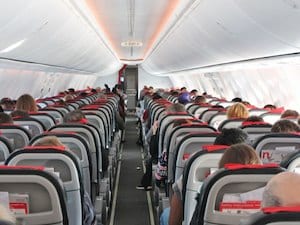
TUESDAY, June 26, 2018 (HealthDay News) — Flight attendants may face higher-than-average risks of breast and skin cancers, a new study finds — though the reasons why aren’t yet clear.
Harvard researchers found that compared with women in the general U.S. population, female flight attendants had a 51 percent higher rate of breast cancer. Meanwhile, their rates of melanoma and non-melanoma skin cancers were about two to four times higher, respectively.
The study, which included over 5,300 U.S. flight attendants, is not the first to find heightened cancer risks among airline crews.
But it’s one of the largest and most comprehensive to look at the issue, according to lead researcher Eileen McNeely.
What’s still unclear is why the pattern is being seen. And because it’s what’s called an observational study, it could not prove cause and effect.
Flight crews have a number of exposures that could potentially play a role, said McNeely, an instructor in environmental health at the Harvard School of Public Health.
“There’s been a lot of speculation about exposure to cosmic ionizing radiation,” she said.
That refers to radiation that comes from outer space. At flight altitudes, people are exposed to higher levels of it. The U.S. National Institute for Occupational Safety and Health (NIOSH) says that of all U.S. workers exposed to radiation, aircrew have the highest average levels.
But no one knows for sure whether cosmic radiation is to blame for flight attendants’ higher cancer risks, McNeely said.
Aircrews can also come in contact with a number of chemicals, she noted. And before smoking bans went into effect, they were habitually breathing secondhand smoke.
Plus, McNeely said, flight crews deal with constant time-zone changes and irregular sleep schedules — which means many disruptions to the body’s circadian rhythm, or “internal clock.”
Circadian disruptions from shift work have been linked to increased risks of obesity and diseases like diabetes and heart disease.
“It’s hard to tease out which of those factors might be more important than others, or whether it’s a combination of all of them,” McNeely said.
However, it’s also possible that there are factors unrelated to flight attendants’ jobs, said Dr. Paolo Boffetta, a professor of oncology and environmental medicine at Mount Sinai’s Icahn School of Medicine, in New York City.
“For example, they may have more UV [sun] exposure because of their opportunity to travel,” said Boffetta, who was not involved in the study.
In addition, he said, women on aircrews may put off having children or have fewer kids, compared with other women. And reproductive factors like that are associated with the risk of breast cancer.
Still, McNeely said, her team found some evidence that the longer flight attendants had been on the job, the higher their cancer risk was. Among women, the risk of non-melanoma skin cancer rose in tandem with job tenure.
That supports the theory that job exposures are the culprit, McNeely said.
The findings, published June 25 in the journal Environmental Health, are based on 5,366 flight attendants who were part of an ongoing Harvard study begun in 2007.
They were surveyed about their health in 2014-15, when they were an average age of 52 years old. McNeely’s team compared their cancer rates with a nationally representative sample of 2,729 adults with similar demographics.
Overall, 3.4 percent of female attendants had been diagnosed with breast cancer, versus 2.3 percent of other U.S. women. Meanwhile, 2.2 percent had been diagnosed with melanoma, compared with just under 1 percent of other women.
The biggest difference was seen in rates of non-melanoma skin cancers — which are highly curable. Over 7 percent of female flight attendants had been diagnosed with those cancers, compared to just under 2 percent of other women.
Male flight attendants had higher rates of skin cancers than other men. But the differences were not significant in statistical terms.
According to McNeely, the findings will “not be news” to aircrews. They’ve long been aware their occupation may be linked to increased cancer risks.
The question is, if the causes are unclear, what can be done? McNeely noted that the European Union has already taken a step — requiring that aircrews be monitored for their radiation exposure. If it reaches a certain level, their work schedules are adjusted.
There are no official radiation limits for U.S. aircrews, according to NIOSH.
Boffetta said that regardless of the reasons, the higher rates of skin and breast cancers among flight attendants underscore an important point: They should get recommended cancer screenings.
The potential risks to flight crews bring up another question: What about passengers who fly frequently?
McNeely said it’s not clear whether they face any health risks. “We study workers first, because they have the greatest exposures,” she noted. “They’re like the canary in the coal mine.”
More information
The U.S. Centers for Disease Control and Prevention has more on radiation from air travel.
